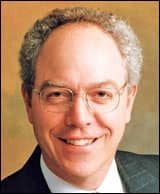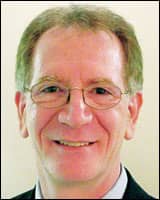by Randall K. Berning, JD, LLM, and Alvin H. Danenberg, DDS, CFP
Careful financial planning will help you enjoy the path to retirement
 |
It’s challenging, and it’s inevitable. A practice transition in one form or another is in your future, if not staring you in the face right now. Most orthodontists have heard or read some material on the subject, but much of the material provides just a broad overview of a relatively complex area. This article will cut to the chase and list specific observations relating to the narrow topic of implementing your transition.
In the area of transition planning, it can be helpful to not only discuss how to avoid difficulties and learn from others’ mistakes, but also to highlight what good planning will produce. Good planning means in part that time frames to accomplish a desired result are realistic. In the list of observations below, I’ve emphasized time frames.
Part 1: How Long Will It Take?
 |
| Randall K. Berning, JD, LLM (Part 1) |
Time frames vary by transaction type, and providing an unrealistic, compressed time for certain transactions can impact the results. For example, with a formal, written practice valuation in hand, the tax treatment of the price and the document set can generally be prepared in 2 to 3 months. In comparison, drawing up a straight employment agreement with a shared understanding of employment terms, including the number of days, compensation, and benefits—if any—can be a 30- to 45-day process from start to finish.
More involved and time intensive than the previous examples can be the sequence of employee to equity owner (through a stock purchase or true partnership), which can take up to 6 to 8 months or longer, including planning for any contingency such as permanent disability, death, or retirement, as well as rehiring of the seller. Additional aspects that orthodontists should allow time to address include options or rights relating to the purchase of the practice facility’s real estate, unusual compensation approaches, planing for trusts for children funded in one way or another by the practice, wholly owned labs, and other arrangements. The second part of this article provides a much-needed commentary on the topic.
The following items are provided to help start the entire process off on the right foot. They are proposed here as an aid to help both owners and prospective associates and partners.
A Shared Time Frame
Both orthodontists should agree on the target dates for building their relationship. It’s pretty easy to discuss starting an associateship and to set a start date when a resident completes his or her program and moves to the practice area. Both orthodontists would likely want an employment agreement ready in advance of the start of the associateship. The best approach is to discuss a firm date for the draft employment agreement to be ready ahead of the start date, so that there is plenty of time to review and discuss it. As noted above, it’s more complicated when the discussion is about a longer-term relationship.
Growth Practices
Good planning for the growth-oriented practice will also address, in the more complex transactions, a number of additional items. These include the number of orthodontists involved at the outset of the partnership and potentially in the coming years, the practice’s present size and its likely size over a 3- to 5-year time frame, the overall strategic plan for the practice and the personal estate planning considerations for the orthodontists, whether there is real estate involved in the practice, and the sophistication of the advisers used. All of these items can impact how best to tailor the ultimate outcome over a given period of time.
When the Relationship Starts with an Associateship
Settle on compensation first. During the 26 years that I’ve been assisting to structure practice relationships, many things have changed. Years ago, discussing compensation came later in the sequence than it does today. Do yourself a favor and understand that the interest of the debt-encumbered younger professional is to find out early in the discussion what the compensation offer is and then if he or she feels comfortable with it. The best approach is to gain an understanding of the regional and local compensation trends and then to reach an understanding on compensation and benefits first, then go through the full employment agreement.
Never leave the practice unprotected. In the states that have enforceable, restrictive covenants, it is essential to take the time to have prepared a well-developed provision to help protect the asset value of the practice. Remember, any such provision must be reasonable and defensible in radius and duration. Any discussion of the future of the practice must seek to create a consensus between the younger and the established orthodontist that protecting the practice is a primary objective. Secure competent legal advice on the covenant. Secure corollary advice on whether to have a liquidated damages provision, a nonsolicitation provision, and a mediation/arbitration provision.
A Longer-Term Relationship
Get the valuation. No matter what the relationship, if it has longer-term aspects, get your practice valuation going. However, if you have a new professional join the practice as an associate partway through the calendar year, there is no rule that states that you should drop everything and secure a valuation. Often there is little impact to waiting until the end of the third quarter or even the end of the calendar year to get solid data on the growth of the practice to use for the current year’s valuation. If the parties want a working number for a buy-in, buy-out, or sale prior to the working relationship’s starting, a valuation prepared with the most recent data and a projection through the current fiscal year is appropriate.
I like to suggest that all orthodontists should gain an understanding of the valuation approach that they want to take. I think you’ll find helpful reading in the ADA publication, Valuing a Practice, and the AAO Practice Transition binder’s, Guide to Orthodontic Practice Value, which discuss the capitalized earning method as a desirable format for a practice valuation. Either engage a professional third-party valuation firm or instruct your CPA to prepare the valuation as described in the materials.
Timing each aspect of a transition is the golden route to success. It informs the younger professional, keeps advisers on track, and gives the orthodontist the practice relationship they desire without undue delay.
Part 2: Approaching Life’s Second Half
 |
| Alvin H. Danenberg, DDS, CFP (Part 2) |
Retirement has been called the career for life’s second half. Up to now, you’ve prepared for the first half of your life. You sacrificed and saved, and took the time to become the best orthodontist you could be. Along the way, you created a lifestyle to share with your significant others.
As retirement approaches, things will change. Fortunately for most of us, there will be opportunities to plan for the transition. You will need to learn about life’s second half. There will be cash flow and investment requirements; health care concerns; lifestyle desires and needs; and housing, insurance, and estate-planning issues. The beauty is that your priorities in life will become more identifiable as you better understand the meaning of your life.
The way you practice orthodontics will be one of your first decisions you deal with as you start your retirement. You may decide to sell your practice and completely retire. Or you may work part-time as an orthodontist. Or you may decide to enter another business full- or part-time. Or you may have to retire for medical reasons. Whatever you decide or are required to do about your practice, you will need to consider the financial, biological, and social changes that will occur during your retirement years.
In preparation for the next half of your life, you will need to identify your goals and expectations. You must analyze your financial status and discover how you will bear the task of funding your retirement years. You may need the help of a retirement specialist like a Chartered Advisor for Senior Living. Your retirement plan will need to be implemented and then monitored annually so that it stays up-to-date and relevant to your life’s changes.
One of the earliest decisions to make concerns your chosen lifestyle during your retirement and how it will be funded. Here are several basic steps to project what you want and what it will cost:
- Determine the cost for you to live your lifestyle today. This is relatively simple. You can examine all your expenses for the previous 12 months, or you can begin to keep an accurate record of these expenses for the next 12 months.
- Add to that figure other things you want to do when you retire. For example, you might include the costs of frequent travel, an expensive hobby, material purchases you have been putting off, or increased health care expenses.
- Subtract from that figure expenses that you would no longer have in retirement. Examples might be saving for a college fund or a retirement nest egg. Taxes you have paid for earned income (Social Security and Medicare taxes) would not need to be paid for cash distributions from your investments. You may not have a home mortgage any longer.
- The resulting annual expense is your cost to retire today with the lifestyle you have chosen. Next, you will need to project that figure to the future date when you plan to retire, taking inflation into consideration. This inflation-adjusted dollar amount will be what it will cost you the first year of retirement to live the lifestyle you have chosen. This and the next step will require the use of a financial calculator or the assistance of a financial planner or Chartered Advisor for Senior Living.
- This last step is more complex, but it is easily done if you understand the concept of the time value of money. You will determine the value of a nest egg that will provide the inflation-adjusted cash flows that will maintain your desired lifestyle from the day you retire until a predetermined date in the future.
Needless to say, these steps are not carved in stone. You can and will make adjustments along the way to compensate for the inaccuracies that are inherent with these projections.
| For more advice about how to handle practice transitions and prepare for retirement, search for “” in our online archives. |
No matter how well you prepare, there can be threats to retirement security. You need to be aware of the following:
- Since there is difficulty in understanding portfolio design and financial planning by yourself, you may frequently need professional advice.
- People differ not only in how they age, but also in the way they react to the changes taking place in their bodies. As one ages, there is an increased likelihood of disease and dependence, and the physical limitations that define the aging process can threaten retirement security.
- The Social Security and Medicare systems are in transition. Medical insurance and long-term care insurance are also in a state of flux.
Life’s second half can be as exciting or more so than the first half. With a plan in place, your uncharted path should go more smoothly, and you should be able to deal with the unexpected events (which definitely will occur) more easily.
Randall K. Berning, JD, LLM, is president of Berning Affiliates Inc. He is the coauthor of two ADA publications: Associateships and Valuing A Practice; the coauthor of the AAO materials on valuation and practice financing; and the publisher of The Expert Series for Dentists™. He has spoken at the AAO practice transition programs, annual meetings, and “Orthodontist as CEO” programs. He is a member of the adjunct faculty at the University of California, San Francisco, School of Dentistry and the University of Maryland, Baltimore, College of Dental Surgery. He can be reached ator at the firm’s Web site, www.BerningAffiliates.com. His new blog is
Alvin H. Danenberg, DDS, CFP, is a certified financial planner and a practicing periodontist in Charleston, SC. He is the author of The Expert Series for Dentists’ five-part financial planning topic, “Accumulating Wealth Series.” Danenberg has written four books regarding money and business management, as well as many articles on financial matters for such publications as Dentistry Today, Dental Economics, Dentists’ Money Digest, Compendium, The Personal Report, and Worth magazine. Danenberg teaches the Investment Planning module at the College of Charleston for students enrolled to become certified financial planners.










